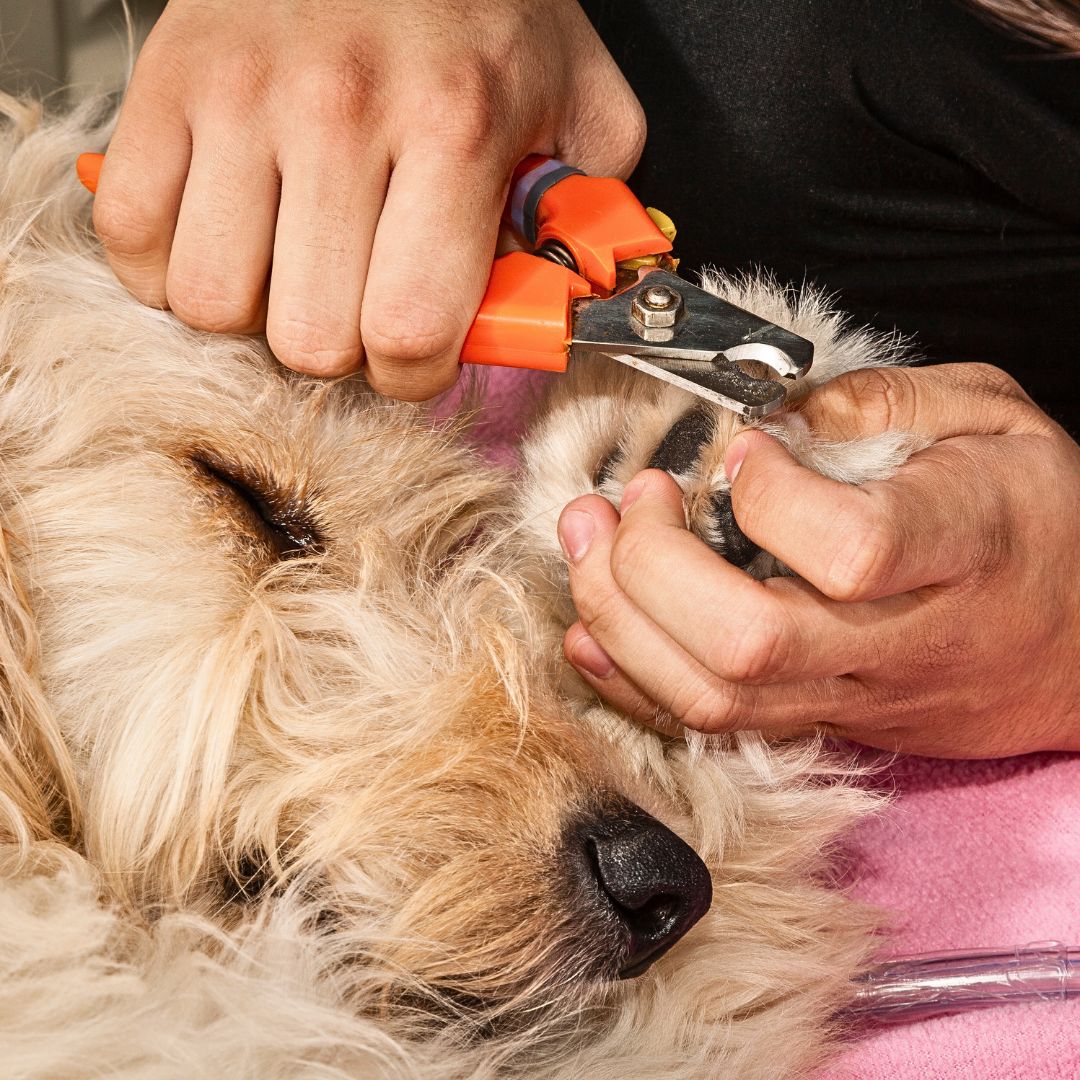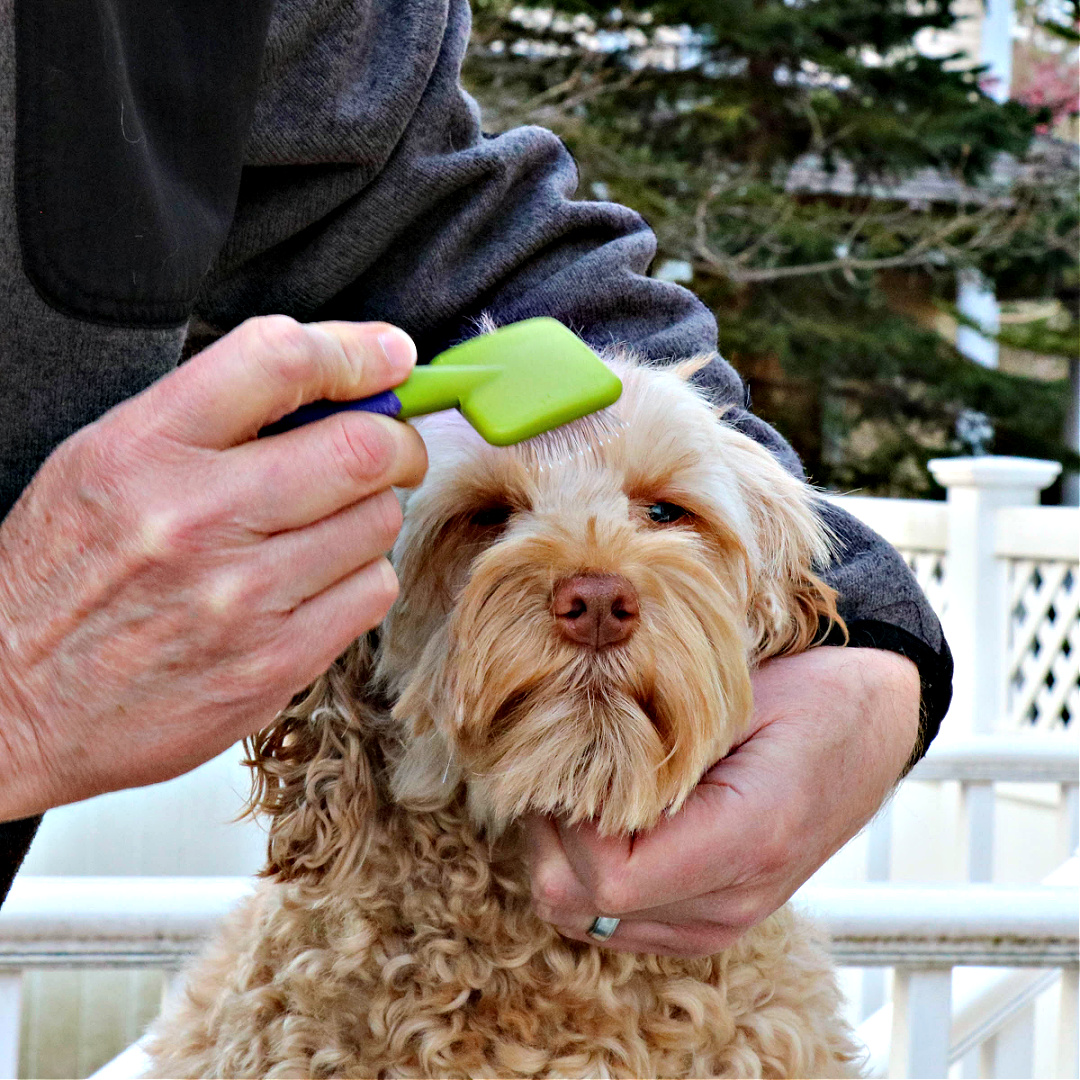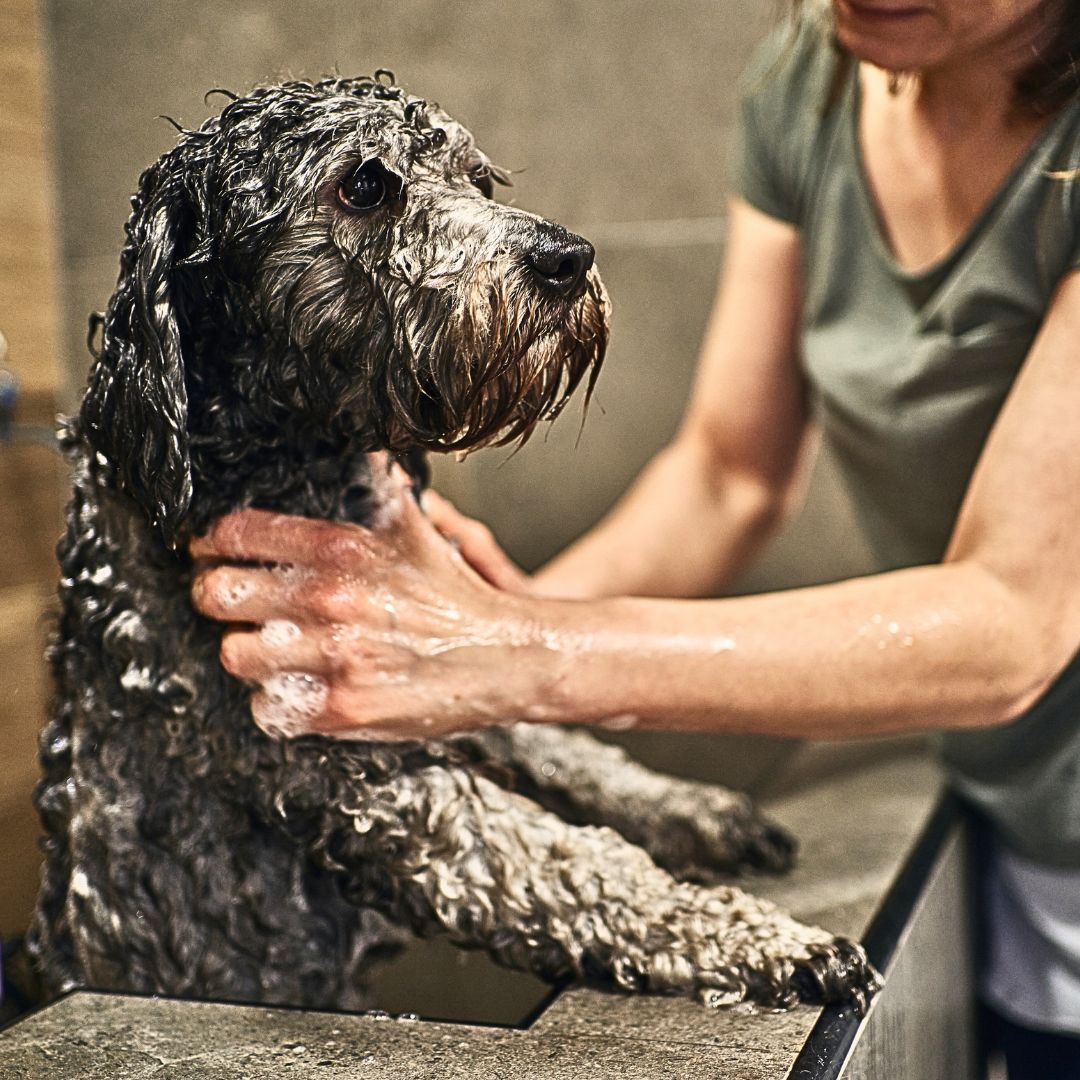Discover the fascinating world of labradoodles and why maintaining their grooming routine is crucial. Uncover the secrets to effectively grooming a labradoodle at Home.
Labradoodles are adorable and lovable dogs that have gained popularity in recent years. They are a crossbreed between Labrador Retrievers and Poodles, known for their charming personalities and hypoallergenic coats.
Regular grooming is necessary to maintain these unique animals’ health and mat/tangle-free skin.
Grooming a Labradoodle involves more than just brushing their fur. Following a proper grooming routine is essential to maintain their coat’s condition and overall well-being. Here are some important tips to keep in mind:
Regular Brushing
Labradoodles have hair that grows continuously, similar to humans. Regular brushing helps remove loose hair, prevents matting, and keeps their coat looking neat and tidy. Aim for at least two to three brushes per week.
Bathing
Labradoodles should be bathed every 4-6 weeks or as needed, using a gentle dog shampoo and conditioner that suits their specific coat type. Avoid over-bathing, as it can strip the coat’s natural oils, leading to dryness or skin irritation. Labradoodles don’t require frequent bathing but may need a rinse if they get dirty from outdoor play. Use a hypoallergenic shampoo when bathing. Soothing oat-based dog shampoo,” says Paola Cuevas, MZV and behavioural specialist.
Nail Trimming
 Labradoodles often require professional grooming services every 6-8 weeks to maintain their coat’s desired length and style. Trimming includes shaping the hair around the face, paws, and tail and removing excessive hair in sensitive areas.
Labradoodles often require professional grooming services every 6-8 weeks to maintain their coat’s desired length and style. Trimming includes shaping the hair around the face, paws, and tail and removing excessive hair in sensitive areas.
Ear Care
Labradoodles have floppy ears that can trap moisture and debris, making them susceptible to ear infections. Regularly check their ears for redness, foul odour, or excessive wax buildup. Clean their ears gently with a veterinarian-approved ear cleaner to prevent diseases and avoid potential issues; ear infections are crucial to maintaining good ear hygiene in Labradoodles, and clean their ears regularly.
Nail Trimming
Keep an eye on your Labradoodle’s nails and trim them regularly, as overgrown nails can cause discomfort or difficulty walking. Consult a professional groomer if you need help cutting them yourself.
Now, let’s discuss the importance of How to Groom a Labradoodle at Home.

Coat Health
Regular grooming helps maintain the health of a Labradoodle’s coat. Brushing removes dead hair and stimulates the skin’s natural oil production, producing a shiny and healthy-looking coat.
Preventing matting
Labradoodles have curly or wavy hair that can easily become matted if not properly maintained. Mats can be painful for dogs and may lead to skin irritation or infection. Regular brushing and professional grooming prevent mats from forming and keep your Labradoodle comfortable.
Allergy-Friendly
Labradoodles are often recommended for people with allergies, as they have a low-shedding coat. However, regular grooming is still necessary to keep their skin clean and minimize the amount of dander in your home. It can help reduce allergy symptoms and make living with a Labradoodle more enjoyable.
Eye and Ear Care
Labradoodles are prone to eye and ear infections due to their floppy ears and hair that can cover their eyes. Regular grooming allows these areas to be cleaned properly, reducing the risk of diseases.
Overall Hygiene
Grooming your Labradoodle ensures it stays clean and fresh-smelling. Bathing removes dirt, debris, odours, and allergens from their coat while promoting good hygiene.
Bonding Time
Grooming sessions are a great way to bond with your Labradoodle. It provides an opportunity for physical contact, allowing you to check for any lumps or abnormalities on their body while also giving them attention and affection.
Professional Expertise
While regular brushing at home is important, professional grooming visits should also be scheduled periodically to ensure proper care of your Labradoodle’s specific coat type. Professional groomers have the knowledge and experience to address any particular needs or concerns related to your dog’s coat health.
Grooming is vital in maintaining your Labradoodle’s overall health, comfort, appearance, and bond. Regular brushing and professional grooming prevent matting, allergies, and infections and provide quality time together. Each dog has unique grooming needs; consulting with a veterinarian or professional groomer can help determine the best practices tailored to your Labradoodle’s requirements.
Step-by-Step Guide: How to Groom Your Labradoodle at Home

Grooming your Labradoodle at home can be a rewarding experience that helps keep your furry friend looking and feeling their best. To guide you through the process, here is a step-by-step guide on how to groom your Labradoodle:
Prepare the grooming area.
Find a clean and well-lit space where you can comfortably groom your Labradoodle. Make sure you have all the necessary grooming tools within reach, such as a brush, comb, dog-friendly shampoo, towels, and clippers if needed.
Brush your Labradoodle’s Coat.
Labradoodles have dense, curly or wavy hair that requires regular brushing to prevent matting. Start grooming using a slicker brush to remove tangles or loose hairs. Then, gently use a comb to work through the coat, ensuring all knots are carefully untangled.
Bathe your Labradoodle
Fill a bathtub with warm water and thoroughly wet your Labradoodle’s coat. Use a dog-friendly shampoo that suits their needs, whether for sensitive skin or to enhance their curls. Gently massage shampoo into their coat and rinse thoroughly to remove all soap residue.
Trim your Labradoodle’s hair.
If your Labradoodle’s hair has grown too long or is bothering them, you may need to trim it. Use pet clippers with an appropriate guard length to ensure you don’t cut too close to the skin. Start from the back of the neck and work down the body, following the direction of hair growth.
Pay attention to ears and eyes.

Keeping Labradoodles’ ears clean and dry is important to prevent ear infections. Use a dog ear cleaner recommended by your vet and gently wipe away any dirt or wax buildup. Similarly, clean around their eyes using a damp cloth or specialized eye wipes to remove debris.
Finish with a final brush.
Once your Labradoodle is dry, brush its coat one last time to remove loose hair and ensure it looks tidy. This step also helps prevent matting and keeps the skin healthy.
Each Labradoodle is unique, so adapting these grooming steps to suit your dog’s specific needs is essential. Take your time, be patient, and reward your Labradoodle with praise or treats throughout the grooming process to make it a positive experience for both of you.
Q: How often should I groom my Labradoodle?
A: When grooming your Labradoodle, it’s important to strike the right balance. The frequency of grooming will depend on various factors, such as the length and texture of their coat, lifestyle, and personal preference. Generally, Labradoodles should be groomed every 6-8 weeks to maintain healthy skin and overall cleanliness.
Bathing your Labradoodle too frequently can affect its natural oils, leading to dryness and irritation. Unless they have gotten exceptionally dirty or smelly, cleaning them once every 4-6 weeks is typically sufficient. However, if your Labradoodle spends much time outdoors or has skin allergies, you may need to bathe them more often.
The Secrets of How to Groom a Labradoodle at Home.
Regular brushing is essential for keeping your Labradoodle’s coat in top shape. Aim to brush them at least once or twice weekly to prevent matting and tangling. If your Labradoodle has a curlier or longer coat, it may require more frequent brushing to prevent knots from forming. Remember to use the appropriate grooming tools for their specific coat type to ensure the best results.
Lastly, remember other aspects of grooming, such as nail trimming, ear cleaning, and dental care. Regularly checking and maintaining these areas will contribute to your Labradoodle’s overall health and well-being.
Always consult a professional groomer or veterinarian for personalized advice based on your Labradoodle’s needs.
Q: Can I use regular shampoo on my Labradoodle?

A: While regular shampoo may be used in certain cases, it is generally recommended to use a shampoo specifically formulated for dogs, especially for Labradoodles. Labradoodles often have sensitive skin, and their unique curly coat requires special care; it’s best to use shampoo formulated for dogs with sharp or curly coats. These shampoos often contain gentle ingredients on the skin that help moisturize the coat and prevent tangles.
By choosing a suitable shampoo for your Labradoodle, you can provide the necessary care and maintain the health of their skin and coat. You must consult a veterinarian or professional groomer for specific recommendations based on your dog’s needs.
Q: Should I trim my Labradoodle’s hair or go to a professional groomer?

A: When deciding whether to trim your Labradoodle’s hair yourself or go to a professional groomer, there are a few factors to consider. Professional grooming offers several advantages. Firstly, groomers have the necessary skills and experience to handle different coat types, including the unique fur of Labradoodles.
They know how to achieve a balanced and aesthetically pleasing trim while ensuring your dog’s comfort and safety. Professional groomers also have access to specialized equipment, such as high-quality clippers and shears, which makes the grooming process more efficient and effective.
Another benefit of professional grooming is that groomers are trained to identify skin conditions, parasites, or other health issues hidden beneath your Labradoodle’s coat. They can alert you to these issues early, allowing prompt treatment to ensure proper hygiene; canine groomers offer additional nail trimming, ear cleaning, and teeth brushing services.
DIY Trimming
On the other hand, some pet owners prefer DIY trimming for various reasons. It can be cost-effective if you have the necessary grooming tools and skills. However, it’s important to note that cutting a Labradoodle’s hair requires precision and knowledge of its specific coat type. Without proper training and experience, you may risk uneven or improper trimming, leading to discomfort for your dog or skin irritation.
Ultimately, the decision between professional grooming and DIY trimming depends on your comfort level, experience, and availability of resources. Suppose you need more clarification about your ability to trim your Labradoodle’s hair effectively or want the peace of mind that comes with professional expertise. In that case, opting for an experienced groomer is usually best. They can provide expert care while ensuring your dog looks and feels its best.
Q: How can I prevent matting in my Labradoole’s coat?
Preventing matting in your Labradoodle’s coat is crucial to maintaining overall health and appearance. Here are some tips and detangling techniques to help you keep your curly hair mat-free:
Regular brushing
Brush your Labradoodle’s coat at least two to three times a week using a slicker brush or a comb with wide-spaced teeth. It will help prevent tangles and remove any loose hair.
Start from the bottom.
Start brushing from the bottom of their coat and work your way up to the top. This technique prevents pulling on the hair, making it easier to remove tangles without causing discomfort.
Use detangling spray
Apply a dog-friendly detangling spray or conditioner before brushing to soften the hair and ease the detangling process. It will also help prevent breakage and minimize discomfort for your pup.
Trimming regularly
Regular visits to a professional groomer are essential for trimming your Labradoodle’s hair. Pruning keeps their coat neat and removes any damaged or tangled hair prone to matting.
Pay attention to problem areas.
Some areas, such as behind the ears, under the legs, and around the tail, are more prone to matting due to friction or moisture. Be sure to pay extra attention to these areas during grooming sessions.
Consider a shorter haircut.
If you find maintaining your Labradoodle’s long, curly coat challenging, consider opting for a shorter haircut. It reduces the risk of matting and makes brushing easier for you and your furry friend.
Remember, consistency is key in preventing matting in your Labradoodle’s coat. Regular grooming and brushing techniques will help keep their hair healthy, tangle-free, and looking its best!
Q: What are some common grooming mistakes to avoid?
A: A few common mistakes should be avoided when grooming your Labradoodle to maintain a healthy coat. Here are some grooming errors to steer clear of:
Using the wrong tools
Using incorrect grooming tools can cause damage to your dog’s coat. Investing in high-quality brushes and combs specifically designed for Labradoodle coats is important. For the proper tools for your dog’s needs, consult a veterinarian or professional groomer.
Over-bathing
While regular bathing is necessary to keep your Over-washing, it can cause dryness and irritation by stripping essential oils from a Labradoodle’s coat. Aim for bathing once every 4-6 weeks or as your veterinarian recommends.
Neglecting regular brushing
Labradoodles have fleece, curly or wavy coats that require daily brushing to help prevent matting and tangling. Neglecting this step can lead to painful mats forming close to the skin, which may require professional grooming or even shaving in extreme cases. Make sure to establish a brushing routine and stick to it.
Cutting hair too short
It’s important to be cautious when trimming your Labradoodle’s hair, especially around sensitive areas such as the face, ears, and tail. Cutting hair too short in these areas can leave them vulnerable to sunburns or irritations. If you need help with how much to trim, consult with a professional groomer for guidance.
Skipping regular grooming appointments
Regular visits to a professional groomer are essential for maintaining your Labradoodle’s coat health. Professional groomers have the expertise to identify potential issues early on and provide proper care, including trimming, nail clipping, and ear cleaning.
By avoiding these common grooming mistakes, you’ll help ensure your Labradoodle’s coat remains healthy and beautiful. Remember, if you have any concerns or questions, it’s always best to seek advice from a professional groomer or your veterinarian.
Conclusion: Enjoy a Well-Groomed and Happy Labradoodle with Regular Home Grooming

Firstly, regular grooming helps to keep your Labradoodle’s coat in optimal condition. Brushing their fur helps to remove tangles, mats, and loose hair. Keeps their coat tidy and prevents any discomfort or irritation caused by tangled skin. Additionally, by removing loose hair through brushing, you can minimize shedding in your home, keeping it cleaner and more hygienic.
Moreover, grooming at home allows you to closely examine your Labradoodle’s skin and fur for any signs of fleas, ticks, or skin infections. Early detection of such problems enables you to take prompt action and seek veterinary care if necessary, preventing further complications.
Regular grooming provides an opportunity to bond with your Labradoodle. The act of grooming can be a calming and relaxing experience for both you and your pet. It allows you to spend quality time together while providing the necessary care and attention. This bonding time promotes trust and strengthens the relationship between you and your Labradoodle.
Furthermore, grooming at home can save you money in the long run. By learning how to groom your Labradoodle yourself, you can avoid frequent visits to professional groomers, which can be costly. With proper tools and techniques, you can maintain your Labradoodle’s coat between professional appointments, ensuring they always look their best.
In summary, regular home grooming for your Labradoodle offers numerous benefits. It helps maintain a healthy and clean coat, prevents tangling and shedding, allows for early detection of skin or fur issues, fosters bonding between you and your pet, and saves money on professional grooming services. So, why not embrace the opportunity to pamper your Labradoodle and enjoy a well-groomed, happy furry companion?







